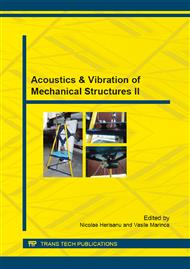[1]
H. Hertz, Über die Berührung fester elastischer Körper, Journal fur die Reine und Andegwandte Mathematik, 1882, 92, 156-171.
DOI: 10.1515/9783112342404-004
Google Scholar
[2]
K.L. Johnson, Contact mechanics, Cambridge University Press, Cambridge, 1985, 154-179.
Google Scholar
[3]
K. Komvopoulos, Finite element analysis of a layered elastic solid in normal contact with a rigid surface, Journal of Tribology, 1988, 110(3), 477-485.
DOI: 10.1115/1.3261653
Google Scholar
[4]
K. Komvopoulos, Elastic-plastic finite element analysis of indented layered media, Journal of Tribology, 1989, 111(3), 430-439.
DOI: 10.1115/1.3261943
Google Scholar
[5]
N. Ye K. and Komvopoulos, Indentation analysis of elastic-plastic homogeneous and layered media: Criteria for determining the real material hardness, Journal of Tribology, 2003, 125(4), 685-691.
DOI: 10.1115/1.1572515
Google Scholar
[6]
L. Kogut and K. Komvopoulos, Analysis of the spherical indentation cycle for elastic-perfectly plastic solids, Journal of materials research, 2004, 19(12), 3641-3653.
DOI: 10.1557/jmr.2004.0468
Google Scholar
[7]
K.L. Johnson, An experimental determination of the contact stresses between plastically deformed cylinders and spheres, Engineering Plasticity, Cambridge University Press. Cambridge, 1968, 341-361.
Google Scholar
[8]
L.Y. Li, C.Y. Wu and C. Thornton, A theoretical model for the contact of elasto-plastic bodies, Journal of Mechanical Engineering Science, 2002, 216(4), 421-431.
Google Scholar
[9]
C. Thornton and Z. Ning, Oblique impact of elasto-plastic spheres, Proceedings of the First International Particle Technology Forum, AIChE Publications, 1994, 2, 14-19.
Google Scholar
[10]
C. Thornton, Coefficient of restitution for collinear collisions of elastic-perfectly plastic spheres, ASME Journal of Applied Mechanics, 1997, 65, 383-386.
DOI: 10.1115/1.2787319
Google Scholar
[11]
C.Y. Wu, L.Y. Li and C. Thornton, Energy dissipation during normal impact of elastic and elastic-plastic spheres, International Journal of Impact Engineering, 2005, 32(1), 593-604.
DOI: 10.1016/j.ijimpeng.2005.08.007
Google Scholar
[12]
L. Kogut and I. Etsion, Elastic-plastic contact analysis of a sphere and a rigid flat, ASME Journal of applied Mechanics, 2002, 69(5), 657-662.
DOI: 10.1115/1.1490373
Google Scholar
[13]
I. Etsion, Y. Kligerman and Y. Kadin, Unloading of an elastic-plastic loaded spherical contact, International Journal of Solids and Structures, 2005, 42(13), 3716-3729.
DOI: 10.1016/j.ijsolstr.2004.12.006
Google Scholar
[14]
R.L. Jackson, I. Green, A Finite Element Study of Elasto-Plastic Hemispherical Contact, ASME Journal of Tribology, 2005, 127(2), 343-354.
DOI: 10.1115/1.1866166
Google Scholar
[15]
M.R. Brake, An analytical elastic-perfectly plastic contact model, International Journal of Solids and Structures, 2012, 49(22), 3129-3141.
DOI: 10.1016/j.ijsolstr.2012.06.013
Google Scholar
[16]
W.J. Stronge, Rigid body collisions with friction, Proceedings of the Royal Society of London. Series A: Mathematical and Physical Sciences, 1990, 431(1881), 169-181.
DOI: 10.1098/rspa.1990.0125
Google Scholar
[17]
W.J. Stronge, Unraveling paradoxical theories for rigid body collisions, ASME Journal of Applied Mechanics, 1991, 58(4), 1049-1055.
DOI: 10.1115/1.2897681
Google Scholar
[18]
W.J. Stronge, Energy dissipated in planar collision, ASME Journal of applied mechanics, 1992, 61, 605-611.
Google Scholar
[19]
A.H. Kharaz, D.A. Gorham, and A.D. Salman, Accurate measurement of particle impact parameters, Measurement Science and Technology, 1999, 10(1), 31.
DOI: 10.1088/0957-0233/10/1/009
Google Scholar
[20]
R.L. Jackson, I. Green, and D.B. Marghitu, Predicting the coefficient of restitution of impacting elastic-perfectly plastic spheres, Journal of Nonlinear Dynamics, 2010, 60(3), 217-229.
DOI: 10.1007/s11071-009-9591-z
Google Scholar
[21]
D.B. Marghitu, D. Cojocaru and R.L. Jackson, Elasto-plastic Impact of a Rotating Link with a Massive Surface, International Journal of Mechanical Sciences, 2011, 53 (4), 309-315.
DOI: 10.1016/j.ijmecsci.2011.01.012
Google Scholar
[22]
H. Ghaednia, D.B. Marghitu and R.L. Jackson, Predicting the permanent deformation after the impact of a rod with a flat surface, Journal of Tribology, 2015, 137 (1), 011403.
DOI: 10.1115/1.4028709
Google Scholar


